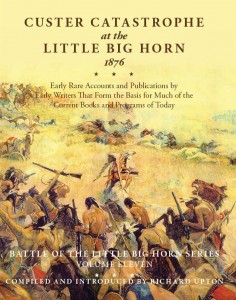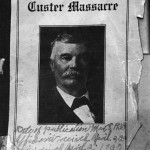Capital A recently worked on the design and production of the latest Upton & Sons book. Richard Upton compiled Custer Catastrophe at the Little Big Horn, 1876 from nine chapters that were originally published in smaller forms, often not with the intention of educating a larger audience in mind. Through the years, these stories have become more and more obsolete, and copies are nearly impossible to find.
Various battle accounts
An account of the Battle of the Little Big Horn written from the point of view of Cheyenne chief Two Moon offers a rare and intriguing tidbit for readers, as “Indian accounts during this period were usually looked upon with skepticism,” Upton points out in the introduction of the book.
Chief Two Moon does not like to detail the battles he went through, but is amiable when approached for the interview:
While he cut his tobacco Wolf Voice interpreted my wishes to him. I said, “Two Moon, I have come to hear your story of the Custer battle, for they tell me you were a chief there. After you tell me the story, I want to take some photographs of you. I want you to signla with a blanket as the great chiefs used to do in fight.”
Wolf Voice made this known to hi, delivering also a message from the agents, and at every pause Two Moon uttered deep-voiced notes of comprehension. “Ai,” “A-ah,” “Hoh,”—these sounds are commonly called “grunts,” but they were low, long-drawn expulsions of breath, very expressive.
Then a long silence intervened. The old man mused. It required time to go from the silence of the hot valley, the shadow of his little cabin, and the wire fence of his pasture, back to the days of his youth. When he began to speak, it was with great deliberation. His face became each moment graver and his eyes more introspective.
“Two Moon does not like to talk about the days of fighting; but since you are to make a book, and the agent says you are a friend to Grinnell, I will tell you about it—the truth. It is now a long time ago, and my words do not come quickly.”
He says he and the other men all thought the fighting was done after their battle at the Rosebud. A couple days later, a messenger gave them other news, and said, “Let everybody paint up, cook, and get ready for a big dance.”
Another example of rare information
According to Upton, only twenty copies of Jacob Adams’s A Story of the Custer Massacre, another account reproduced in this volume, were ever printed, so Custer Catastrophe holds a unique opportunity to read this first-hand account that not many people have been in contact with.
Adams, who was on the frontier for seven years and spent five years with the Seventh Cavalry, writes his book in a very straightforward manner, displaying his confidence and character throughout his rendition of the battles the unit faced. One particularly telling scene of Adams’s persona comes when he details an expedition he participated in at the mouth of the Powder River:
“When we arrived there about June 15th, 1876. We laid down for a few days evidently waiting for something. In the meantime a half breed Sioux Indian came to our camp declaring that he had deserted Sitting Bull’s camp and wished to join our camp. General Custer trained him for a scout. This half breed Sioux was a spy and betrayed General Custer. He rode at the head of the column with General Custer and as I claim was a spy and the reader will claim so too after they read this book.”
Details, straight from the source
Along with the stories of the fight and the interviews with different people who participated in the battles, the last section of this compilation is Comments by General Fry on the Custer Battle, which is an interesting read about the actual details of the battle. While much myth and lore surrounds the battles during this time period, General Fry tells readers what happened from his perspective.
He points out the odd statistics that affected the battle with an official report of 1876: “Up to the moment of Custer’s defeat there was nothing, official or private, to justify an officer to expect that any detachment would encounter more than 500 or 800 warriors.” In fact, the Custer fight was made up of 2,500 to 3,000. Though the failure of the battle has been attributed to “departure from the ‘plan,’” General Fry says, “the utter failure of our campaign was due to underestimating the numbers and prowess of the enemy.”
Book info
Upton & Sons, Publishers · Copyright 2012 · ISBN 978-0-912783-49-9
Trade Edition $55.00 · Signed, numbered, specially bound limited edition (only 50 copies) $150.00

